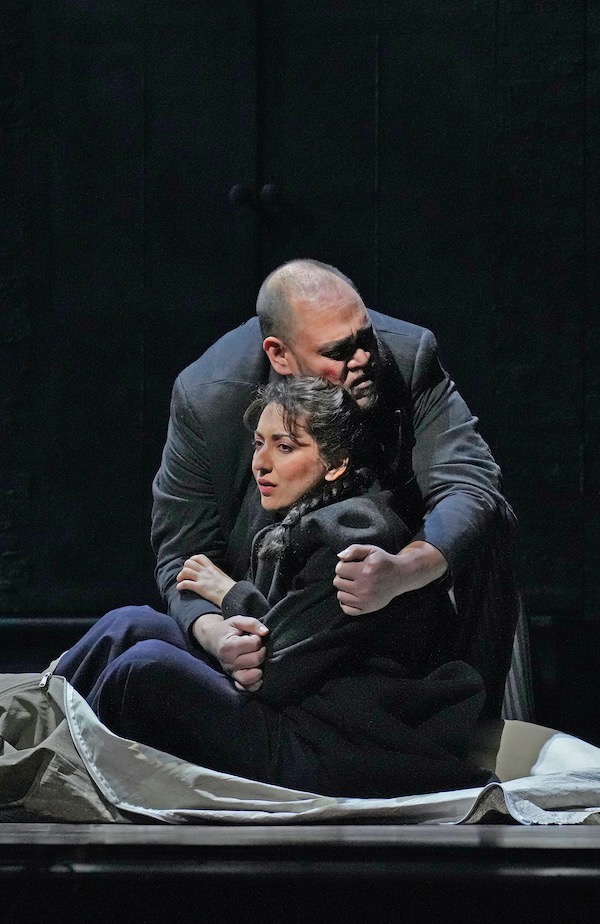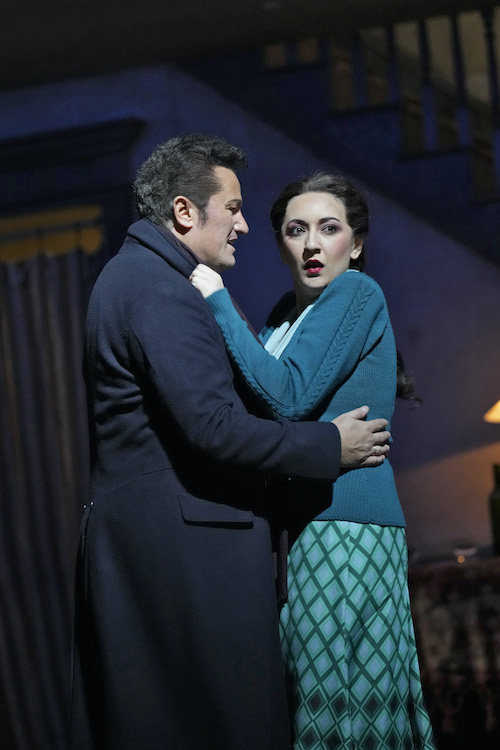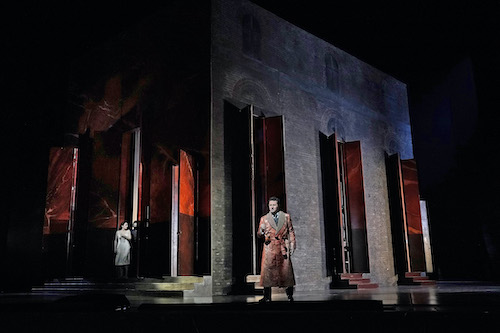Superb singing, stylish conducting lift Met’s new “Rigoletto” out of the visual murk

The Metropolitan Opera rang in the new year Friday evening with the opening of a new production of Rigoletto. Verdi’s opera of love, revenge, and murder may not be the first thought for a festive occasion, but it’s one of the most gripping of all music dramas, especially when put into a relevant context for contemporary audiences.
That was exactly what Michael Mayer’s celebrated 2013 production did by setting the story in 1950s Las Vegas. For some reason the Met decided to commission a new production from Bartlett Sher, with the “cooperation” of the Staatsoper Berlin. Despite some fine music-making and strong singing Friday, one was left mystified by what the new production is supposed to do, and why it even exists.
As a purely vocal matter this was a high-level performance. The Rigoletto for this epic run—the schedule extends into June—is baritone Quinn Kelsey, a veteran of the Met stage. With soprano Rosa Feola as his daughter Gilda, and tenor Piotr Beczała as the Duke of Mantua, the principals made a trio that was vocally inspired if slightly lopsided dramatically.
The principals all shared a sterling vocal quality, singing with great projection and color. Kelsey sang with a virile energy and excellent articulation, Feola showed a shapely legato all night, and Beczała was technically masterful, showing a piping quality only on the highest notes. With conductor Daniele Rustioni ably managing the balances, this was the clearest vocal and instrumental sound one has heard at the Met all season. Every articulation came through, and one felt the weight and substance of the voices and the music. Much of this was due to a nuanced dynamic palette, with everyone, including the chorus, holding back their maximum volume save for a few key moments. The Act III quartet, “Bella figlia dell’amore,” with the principals—and mezzo-soprano Varduhi Abrahamyan making a stylish Met debut as Maddalena—was big but somewhat plodding. Rustioni seemed to be guiding the music with caution at times, rather than the incisive drive one had heard from the pit since the Prelude.
As the title jester, Kelsey was intensely charismatic, and did it almost entirely with his voice, augmented with an anxious stage presence. He sang with easy power, but even more he played with phrasing and rubato, punching certain words and pushing and pulling the music past the bar lines. The character stood out against the orderly rhythms of the Duke and his courtiers, musically defining the social divisions between the two. The dramatic effect of this is that the mockery that Rigoletto and the court share for each other seemed jarring and real. His “Cortigiani” was thrown out with an anger that was gripping.
Feola sang with ease and naturalness, her warm, light sound ideal for the doomed Gilda. Her “Caro nome” was lovely and touching, and the delicacy of her sound was a vivid expression and definition of the character. Again, one was impressed with how effective the music-making was when the singers and musicians limited their volume. The contrast between this, her pleas with her father, her chest sound in Act III, disguised as a man, made the violence at the end even more intense than usual. There was a real transformation in the character, a journey to tragedy.
Kelsey and Feola were terrific in their scenes together. One of the strengths of the evening was hearing their father and daughter interact as the drama unfolded. From “Figlia! Mio Padre!” in Act I through to the brief dialogue before the deceptively pastoral music that presages the end of things, the pair stepped out of the social millieu of Mantua into their own world of safety and love. The expressive qualities of Feola’s voice were heightened in contrast with Kelsey, and he took on a tender and more rounded tone that contrasted with his aggressive style in the other settings.

Though he has the range for the music and sang well, Beczała seemed miscast as the Duke. His boyish, earnest presence makes him a great straight man and foil, as with Lensky in Eugene Onegin. But he doesn’t possess the seductive style and raffish charisma the Duke needs, as embodied by Matthew Polenzani in this same opera. As he wooed Gilda, one felt he was a boy scout play acting the part. “La donna è mobile” sounded strong and lively, and brought down the house, but it was dramatically superficial. One wanted some of the overt sexuality and jaunty sociopathy that makes the Duke a true villain.
The singing was uniformly fine through the entire cast, each secondary character singing with the same clarity and projection as the principals. As the assassin Sparafucile, bass Andrea Mastroni had a confident insolence from his very first appearance. Bass-baritone Craig Colclough was vivid as Monterone, expressing some of the most intense passion of the evening in his appearances. His energy punched up the entire opera.
Mastroni’s natural villainy in Act III captured the Verdian concept of everyday life through song. It was also nice to finally be able to see him on stage, because in Act I, he was nearly invisible. This was the fault of Sher’s production and Michael Yeargan’s sets, which were tasteful but ordinary. Ostensibly set in Germany during the Weimar Republic, one would only know this by reading the program notes, as there was barely anything in Yeargan’s scenic design that defined the place and era as such, except for a vague sense of Mantua existing in some liminal stage between monarchy and modernism.
The main color in the production was black (outlined with some oxblood and gold), and the fundamental visual element was black leather trenchcoats (a cliche in itself) against a black background. With this and a black hat, Sparafucile was camouflaged against the night. While this could have been a workable dramatic idea on its own, with so many other characters, including the chorus, presented in the same way, the effect was that this important character was nothing special.
As the Mayer production showed, the ancient court milieu of Rigoletto can be made relevant to contemporary audiences by putting it in the context of a place where laws and morals are contingent on personal wealth and social power. This is easy to understand for 21st-century American audiences, and the Mayer production was not just stylish but also one of the most meaningful things the Met has put on stage this century.
Weimar Germany is endlessly name-checked in hip culture by people whose knowledge seems to begin and end with Cabaret. Unfortunately, there’s nothing of the musical’s style or era-setting in this production. There’s also no hint that anyone like Max Beckmann, F.W. Murnau, Marlene Dietrich, or Bertolt Brecht ever existed.
There’s a strong case to be made that Rigoletto is a proto-Brecht drama, and certainly the actual features of the Weimar Republic could be a compelling setting for the opera. It’s a shame such an excellent cast is fronting a new production that comes off as an empty bill of goods.
Rigoletto continues through June 1 with cast changes. metopera.org








